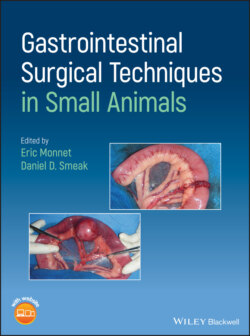Читать книгу Gastrointestinal Surgical Techniques in Small Animals - Группа авторов - Страница 55
Bibliography
Оглавление1 Bellenger, C. (1982). Comparison of inverting and appositional methods of anastomosis of the small intestines in cats. Vet. Rec. 110: 265–268.
2 Chassin, J.L., Rifkind, K.M., and Tumer, J.W. (1984). Errors and pitfalls in stapling gastrointestinal tract anastomoses. Surg. Clin. North Am. 64: 441–459.
3 Chung, R.S. (1987). Blood flow in colonic anastomoses. Effect of stapling and suturing. Ann. Surg. 206: 335–339.
4 Davis, D.D., Demianiuk, R.M., Musser, J. et al. (2018). Influence of preoperative septic peritonitis and anastomotic technique on the dehiscence of enterectomy sites in dogs. A retrospective review of 210 anastomoses. Vet. Surg. 47: 125–129.
5 Ellison, G. (1989). Healing in the gastrointestinal tract. Semin. Vet. Med. Surg. (Small Anim.) 4: 287–293.
6 Getzen, L.C., Roe, R.D., and Holloway, C.K. (1966). Comparative study of intestinal anastomotic healing in inverted and everted closures. Surg. Gynecol. Obstet. 123: 1219–1227.
7 Goligher, J.C., Lee, P.W., Simpkins, K.C. et al. (1977). A controlled comparison of one‐ and two‐layer techniques of suture for high and low colorectal anastomoses. Br. J. Surg. 64: 609–614.
8 Graham, M.F., Diegelmann, R.F., Elson, C.O. et al. (1988). Collagen content and types in the intestinal strictures of Crohn's disease. Gastroenterology 94: 257–264.
9 Halstead, W.S. (1887). Circular suture of the intestine. An experimental study. Am. J. Med. Sci. 94: 436–461.
10 Hamilton, J.E. (1967). Reappraisal of open intestinal anastomoses. Ann. Surg. 165: 917–924.
11 Hogstrom, H., Haglund, U., and Zederfeldt, B. (1990). Tension leads to increased neutrophil accumulation and decreased laparotomy wound strength. Surgery 107: 215–219.
12 Hunt, T.K., Cederfeldt, B., and Goldstick, T.K. (1969). Oxygen and healing [review]. Am. J. Surg. 118: 521–525.
13 Jansen, A., Becker, A.E., Brummelkamp, W.H. et al. (1981). The importance of apposition of the submucosal intestinal layers for primary wound healing of intestinal anastomoses. Surg. Gynecol. Obstet. 152: 51–58.
14 Kieves N., Thompson D.A. and Krebs A.I. (2014). Comparison of ex vivo leak pressures for single‐layer enterotomy closure between novice and trained participants in a canine model. Scientific Presentation Abstracts: 2014 ACVS Surgery Summit October 16–18, San Diego, CA.
15 McAdams, A.J., Meikle, A.G., and Taylor, J.O. (1970). One layer or two layer colonic anastomoses? Am. J. Surg. 120: 546–550.
16 Moy, R.L., Waldman, B., and Hein, D.W. (1992). A review of sutures and suturing techniques. J. Dermatol. Surg. Oncol. 18: 785–795.
17 Orr, N.W.M. (1969). A single‐layer intestinal anastomosis. Br. J. Surg. 56: 771–774.
18 Sajid, M.S., Siddiqui, M.R.S., and Baig, M.K. (2012). Single layer versus double layer suture anastomosis of the gastrointestinal tract. Cochrane Database Syst. Rev. 18 (1): CD005477. https://doi.org/10.1002/14651858.CD005477.
19 Snowden, K.A., Smeak, D.D., and Chiang, S. (2016). Risk factors for dehiscence of stapled functional end‐to‐end intestinal anastomoses in dogs: 53 cases (2001–2012). Vet. Surg. 45: 91–99.
20 Thornton, F.J. and Barbul, A. (1997). Healing in the gastrointestinal tract. Surg. Clin. N. Am. 77: 549–573.
21 Udenfriend, S. (1966). Formation of hydroxyproline in collagen [review]. Science 152: 1335–1340.
22 Weisman, D.L., Smeak, D.D., Birchard, S.J. et al. (1999). Comparison of a continuous suture pattern with a simple interrupted pattern for enteric closure in dogs and cats: 83 cases (1991–1997). J. Am. Vet. Med. Assoc. 214: 1507–1510.
